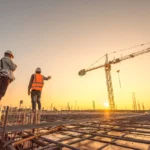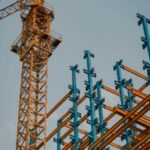Introduction
In the ever-evolving world of construction, innovation is not just a buzzword—it’s a necessity. The industry, once dominated by traditional methods, is now embracing a myriad of innovative construction techniques that promise to transform how we build, live, and work. From 3D printing to smart building technologies, these advancements are setting new standards for efficiency, quality, and sustainability.
3D Printing in Construction
Definition and Process
3D printing, also known as additive manufacturing, involves creating three-dimensional objects from a digital file by layering materials. In construction, this technology uses materials like concrete, plastics, and metals to “print” building components or entire structures. Imagine a giant printer laying down layers of concrete to form walls, one atop another, until the entire building takes shape.
Benefits and Applications
The benefits of 3D printing in construction are manifold. Firstly, it significantly reduces waste by using precise amounts of material. Secondly, it accelerates construction timelines, as components can be printed in a fraction of the time it would take using traditional methods. Additionally, 3D printing allows for complex designs that would be difficult or impossible to achieve with conventional techniques.
Case Studies of Successful Projects
Several projects worldwide have showcased the potential of 3D printing. For instance, in Dubai, the world’s first 3D-printed office building stands as a testament to this technology’s capabilities. This project not only reduced construction time by 50% but also cut labor costs by 80%. Another notable example is the 3D-printed bridge in Madrid, Spain, which highlights the material efficiency and innovative design possibilities offered by this technology.
Modular Construction
What is Modular Construction?
Modular construction involves creating building sections, or modules, in a factory setting before transporting and assembling them on-site. These modules can be anything from single-room units to complete sections of buildings, designed to fit together like pieces of a puzzle.
Advantages of Modular Construction
The advantages of modular construction are compelling. Speed is a major factor; building modules in a controlled environment allows for concurrent site preparation and module construction, drastically reducing overall project timelines. Additionally, this method enhances quality control, as factory settings provide consistent conditions, reducing the variability that can occur on traditional construction sites. Furthermore, modular construction is environmentally friendly, minimizing waste and maximizing the efficient use of materials.
Real-World Examples
One prominent example of modular construction is the world’s tallest modular hotel, the AC Marriott in New York. The building’s 168 modules were constructed off-site and then assembled on-site in just 90 days. Another example is the 500-bed hospital in Wuhan, China, which was built in just 10 days to address the urgent need during the COVID-19 pandemic, showcasing the speed and efficiency of modular construction.
Advanced Building Materials
Introduction to Advanced Materials
The construction industry continually seeks new materials that offer enhanced performance and sustainability. Advanced building materials are engineered to provide superior properties compared to traditional options, making them invaluable in modern construction.
Types of Advanced Building Materials
- Self-healing Concrete: This innovative material contains bacteria that produce limestone to heal cracks automatically.
- Aerogel Insulation: Known for its exceptional insulating properties, aerogel is lightweight and highly effective in reducing energy loss.
- Transparent Aluminum: Offering the strength of metal with the transparency of glass, this material is ideal for secure and aesthetic building designs.
- Graphene: Used in coatings and composites, graphene enhances durability and resistance to wear and tear.
Benefits and Applications
Advanced building materials offer numerous benefits, including improved durability, energy efficiency, and environmental sustainability. Self-healing concrete, for instance, extends the lifespan of structures and reduces maintenance costs. Aerogel insulation drastically cuts heating and cooling expenses, making buildings more energy-efficient. Transparent aluminum provides high security without compromising on aesthetics, suitable for modern architectural designs.
Smart Building Technologies
What are Smart Buildings?
Smart buildings leverage technology to enhance the efficiency, comfort, and security of structures. These buildings use integrated systems and the Internet of Things (IoT) to monitor and manage various aspects, from lighting and HVAC to security and energy consumption.
Features of Smart Buildings
Smart buildings feature advanced systems that provide real-time data and control. Automated lighting adjusts based on occupancy and natural light, reducing energy use. Smart HVAC systems learn and adapt to occupant preferences, optimizing comfort and efficiency. Security systems include smart locks, surveillance cameras, and access controls, enhancing safety.
How Mega Diamond Incorporates Smart Technologies
At Mega Diamond, we incorporate the latest smart technologies in our projects. Our buildings feature smart thermostats, automated lighting systems, and energy-efficient appliances, ensuring optimal performance and reduced operational costs. Additionally, our integrated security systems offer enhanced protection and peace of mind for residents and businesses alike.
Project Management in Modern Construction
The Role of Project Management
Effective project management is crucial in modern construction. It ensures projects are completed on time, within budget, and to the desired quality standards. Project managers coordinate all aspects of a project, from planning and resource allocation to execution and monitoring.
Techniques and Tools for Effective Project Management
Several techniques and tools can enhance project management in construction:
- Building Information Modeling (BIM): BIM provides a digital representation of the physical and functional characteristics of a project, enabling better decision-making and collaboration.
- Gantt Charts: These visual timelines help project managers plan, coordinate, and track specific tasks and milestones.
- Lean Construction: This methodology focuses on minimizing waste and maximizing value throughout the construction process.
- Project Management Software: Tools like Microsoft Project and Primavera streamline project planning, scheduling, and tracking, enhancing efficiency and communication.
Mega Diamond’s Project Management Approach
At Mega Diamond, our project management approach combines advanced techniques and tools to ensure successful project outcomes. We use BIM to facilitate collaboration and decision-making, ensuring all stakeholders have a clear understanding of the project’s progress. Our project managers employ lean construction principles to optimize efficiency and reduce waste. Additionally, we leverage project management software to track timelines, budgets, and resources, ensuring projects are delivered on time and within budget.
Conclusion
In conclusion, the construction industry is undergoing a significant transformation, driven by innovative techniques and technologies. From 3D printing and modular construction to advanced building materials and smart building technologies, these advancements are reshaping how we build and live. Mega Diamond General Contracting LLC is at the forefront of this innovation, committed to delivering high-quality, sustainable, and efficient construction solutions. As we look to the future, embracing these innovative techniques will be crucial in meeting the evolving needs of our clients and the environment.
FAQs
What is the most innovative construction technique today?
One of the most innovative construction techniques today is 3D printing, which allows for the creation of complex structures quickly and with minimal waste.
How does 3D printing benefit the construction industry?
3D printing benefits the construction industry by reducing waste, accelerating project timelines, and enabling the creation of complex designs that are difficult to achieve with traditional methods.
What are the main advantages of modular construction?
The main advantages of modular construction include faster project timelines, improved quality control, reduced waste, and enhanced sustainability.
What are some examples of advanced building materials?
Examples of advanced building materials include self-healing concrete, aerogel insulation, transparent aluminum, and graphene, each offering unique benefits for durability, energy efficiency, and security.
How can smart building technologies improve construction?
Smart building technologies can improve construction by enhancing efficiency, comfort, and security through integrated systems that monitor and manage various aspects of building operations, from lighting and HVAC to security and energy consumption.












